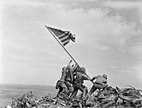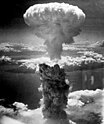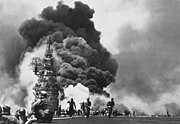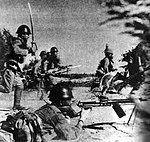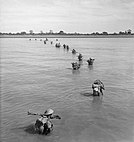Perang Pasifik
Perang Pasifik atau Perang Asia Pasifik, atau yang dikenal di Jepang dengan nama Perang Asia Timur Raya (Greater East Asia War (大東亜戦争, Dai Tō-A Sensō)) adalah perang yang terjadi di Samudra Pasifik, pulau-pulaunya, dan di Asia. Konflik ini terjadi antara tahun 1937 dan 1945. Namun peristiwa-peristiwa yang lebih penting terjadi setelah 7 Desember 1941, ketika Jepang menyerang Pearl Harbor, Amerika Serikat serta koloni negara Sekutu di Asia dan Pasifik, yang membuat Amerika Serikat terlibat dalam Perang Dunia II bersama Sekutu.
| Perang Pasifik | |||||||||
|---|---|---|---|---|---|---|---|---|---|
| Bagian dari Perang Dunia II | |||||||||
| |||||||||
| |||||||||
| Pihak terlibat | |||||||||
|
Blok Sekutu: |
Blok Poros: | ||||||||
| Tokoh dan pemimpin | |||||||||
|
|
Wang Jingwei | ||||||||
| Kekuatan | |||||||||
|
|
| ||||||||
| Korban | |||||||||
| |||||||||
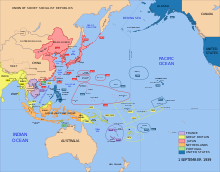
Perang Tiongkok-Jepang Kedua antara Kekaisaran Jepang dan Republik Tiongkok telah berlangsung sejak 7 Juli 1937, dengan permusuhan sejak 19 September 1931, karena Jepang melancarkan invasi ke Manchuria.[44] Namun, ini lebih diterima secara luas [e][45] bahwa Perang Pasifik itu sendiri dimulai pada 7-8 Desember 1941, ketika Jepang menginvasi Thailand dan menyerang koloni Britania di Malaya, Singapura, dan Hong Kong serta serangan mendadak Jepang ke pangkalan militer dan Angkatan Laut Amerika Serikat di Pearl Harbor, Pulau Wake, Guam, dan Filipina. [46] [47][48] Melindungi "Perang Pasifik": Perlindungan sebagian bawaan untuk semua AP. Pada Perang Pasifik ini, terlihat gabungan pasukan Sekutu diadu melawan Jepang, yang terakhir dibantu oleh Thailand dan pada tingkat yang lebih rendah oleh negara sesama blok Poros seperti Jerman dan Italia. Pertempuran terdiri dari beberapa pertempuran laut terbesar dalam sejarah, dan pertempuran yang sangat sengit dan kejahatan perang di seluruh Asia dan Kepulauan Pasifik, yang mengakibatkan hilangnya nyawa manusia yang sangat besar. Perang terus memuncak dengan terjadinya serangan udara di Jepang, dan pengeboman atom di Hiroshima dan Nagasaki, disertai dengan Pernyataan perang Uni Soviet terhadap Jepang, invasi Manchuria dan wilayah lain pada tanggal 9 Agustus 1945, menyebabkan Jepang mengumumkan niatnya untuk menyerah pada tanggal 15 Agustus 1945. Upacara resmi penyerahan Jepang berlangsung di atas kapal perang USS Missouri di Teluk Tokyo pada tanggal 2 September 1945. Setelah perang, Jepang kehilangan semua hak dan hak milik bekas kepemilikan di Asia dan Pasifik, dan kedaulatannya terbatas pada empat pulau utama dan pulau kecil lainnya sebagaimana ditentukan oleh Sekutu. [49]
Akibat Perang Pasifik
Berikut ini adalah beberapa akibat dari Perang Asia Pasifik yang terjadi antara tahun 1937 sampai 1945 ini:
- Kekalahan Jepang membuatnya kehilangan wilayah jajahannya seperti Manchuria, Korea, Asia Tenggara dan daerah mandat di kepulauan Pasifik yang diberikan pada akhir Perang Dunia II.
- Beberapa negara yang sebelumnya dijajah oleh negara-negara Eropa berhasil memperoleh kemerdekaan seperti Indonesia.Hal ini bisa dikatakan mengakhiri tidak hanya Indonesia namun juga berakhirnya kekuasaan kolonial Jepang atas orang kulit berwarna oleh orang kulit putih.
- Kaisar Jepang kehilangan statusnya sebagai dewa. Amerika Serikat sebagai pemenang perang di Pasifik tidak ingin mengadili Hirohito, kaisar Jepang saat itu. Amerika Serikat membutuhkan daerah penyangga (buffer) untuk menahan arus pengaruh komunisme karena Rusia sudah mencapai kawasan timur Asia.
- Jepang tidak diperbolehkan mempunyai angkatan perang, kecuali pasukan pembela diri.
Penjelasan
- ^ Fighting an undeclared war against Japan since 7 July 1937, declared war 9 December 1941.[1]
- ^ Meskipun Jepang telah menginvasi dan menduduki Tiongkok sejak 1937, perang tidak dideklarasikan secara resmi. Jepang kemudian menyerang Pearl Harbor pada tanggal 7 Desember 1941, yang membawa perang yang terjadi di Tiongkok ke dalam konflik global yang lebih luas.[1]
- ^ Until April 1945
- ^ Until July 1945
- ^ "For fifty-three long months, beginning in July 1937, China stood alone, single-handedly fighting an undeclared war against Japan. On 9 December 1941, after Japan's surprise attack on Pearl Harbor, China finally declared war against Japan. What had been for so long a war between two countries now became part of a much wider Pacific conflict."[1]
Catatan kaki
- ^ Strength of the US Military in Asia and the Pacific as of war's end: Army: 4,000,000,[4] Navy (excluding Coast Guard and Marines): 1,366,716,[5] and Marine Corps: 484,631.[6] These figures do not include the Coast Guard or naval personnel in the China-Burma-India theater.[7]
- ^ These numbers do not include the Royal Netherlands Navy.
- ^ 3.8 million Chinese military deaths (1937–45; 3.2 million Nationalist/-allied and 580,000 Communist),[18] 370,0881 United States casualties (at least 111,914 killed [including 13,395 who died as POWs and 5,707 who died of wounds], 248,316 wounded and missing, 16,358 captured and returned),[19][20] 52,000 British casualties including 12,000 deaths in captivity,[butuh rujukan] 87,028 British Indian soldiers killed[21][22][halaman dibutuhkan] 17,501 Australians killed[23] 27,000 killed (including POWs who died in captivity), 70,000+ captured (not including those who died), unknown wounded from the Philippine Commonwealth (not including guerrilla forces),[24] around 9,400 Dutch killed including 8,500 who died in captivity (likely not including colonial forces),[butuh rujukan] 578 New Zealander casualties,[25] 63,225 Soviet casualties (12,031 killed and missing, 42,428 wounded and sick; does not count the 1938–1939 Soviet-Japanese Border Wars), 5000 French military casualties in Indochina, 300 Mongolian casualties[26] and 5 Mexican deaths[27] Malaria was the most important health hazard encountered by U.S. troops in the South Pacific during World War II, where about 500,000 men were infected.[28]
- ^ Over 17 million Chinese civilian deaths (1937–45);[18] around 4 million civilian deaths from the Dutch East Indies;[22][halaman dibutuhkan], 1-2 million Indochinese civilians;[29] around 3 million[30] Indian civilian deaths in the Bengal famine of 1943; 0.5 to 1 million[31] Filipino civilian deaths; 250,000[32] to 1,000,000[33] Burmese civilian deaths; 50,000[34] East Timorese civilian deaths; and hundreds of thousands of Malayan, Pacific and other civilian deaths.[22][halaman dibutuhkan]
- ^ 2,133,915 Japanese military deaths 1937–45,[37] 1.18 million Chinese collaborator casualties 1937–45 (432,000 dead),[38] 22,000 Burmese casualties,[butuh rujukan] 5,600 Thai troops killed,[39] and 2,615 Indian National Army (Azad Hind) killed/missing.[40]
- ^ 460,000 Japanese civilian deaths (338,000 in the bombings of Japan,[41] 100,000 in the Battle of Okinawa, 22,000 in the Battle of Saipan), 543,000 Korean civilian deaths (mostly due to Japanese forced labor projects),[42] 2,000-8,000 Thai civilian deaths[43]
Referensi
- ^ a b c Hsi-sheng Ch'i, in James C. Hsiung and Steven I. Levine, China's Bitter Victory: The War with Japan 1937–1945, M.E. Sharpe, 1992, p. 157.
- ^ Sun, Youli (15 September 1996). China and the Origins of the Pacific War, 1931–41. Palgrave MacMillan. hlm. 11. ISBN 978-0-312-16454-6.
- ^ Hastings pg. 205
- ^ Coakley and Leighton (1989). Global Logistics and Strategy 1943–1945 pg. 836
- ^ US Navy Personnel in World War II Service and Casualty Statistics, Naval History and Heritage Command Table 9.
- ^ King, Ernest J. (1945). Third Report to the Secretary of the Navy pg. 221
- ^ US Navy Personnel in World War II Service and Casualty Statistics, Naval History and Heritage Command Footnote 2.
- ^ a b Hastings pg. 10
- ^ "Chapter 10: Loss of the Netherlands East Indies". The Army Air Forces in World War II: Vol. 1 – Plans & Early Operations. HyperWar. Diakses tanggal 31 August 2010.
- ^ Cherevko, "Hammer and Sickle against Samurai Sword" ch. 7 table 7. Combined ground, air, anti-air, and naval personnel.
- ^ Cook (1992). Japan at War: an Oral History. New Press. ISBN 978-1-56584-039-3. pp. 403. Japanese strength is given at 4,335,500 in the Home Islands and 3,527,000 abroad.
- ^ Harrison pp. 29 Retrieved 10 March 2016
- ^ Australia-Japan Research Project, "Dispositions and Deaths" Retrieved 10 March 2016
- ^ Meyer, Milton Walter (1997). Asia: A Concise History. Lanham: Rowman & Littlefield. hlm. 309. ISBN 978-0-8476-8063-4.
- ^ Jowett, pp. 72
- ^ www.navsource.org Retrieved 25 July 2015; www.uboat.net Retrieved 25 July 2015; Major British Warship Losses in World War II. Retrieved 25 July 2015; Chinese Navy Retrieved 26 July 2015.
- ^ Hara, Tameichi, with Fred Saito and Roger Pineau. Japanese Destroyer Captain (Annapolis: Naval Institute Press, 2011), p. 299. Figure is for U.S. losses only. China, the British Commonwealth, the USSR and other nations collectively add several thousand more to this total.
- ^ a b "Chinese People Contribute to WWII". Diakses tanggal 23 April 2009.
- ^ "United States Dept. of the Army, Army Battle Casualties and Non Battle Deaths in World War II". Cgsc.cdmhost.com. Diarsipkan dari versi asli tanggal 12 May 2010. Diakses tanggal 2011-06-15.
- ^ Michael Clodfelter. Warfare and Armed Conflicts – A Statistical Reference to Casualty and Other Figures, 1500–2000. 2nd Ed. 2002 ISBN 0-7864-1204-6. p 585
- ^ Commonwealth War Graves Commission Annual Report 2013–2014, page 44. Figures include identified burials and those commemorated by name on memorials.
- ^ a b c Dower, John William (1987), War Without Mercy: Race and Power in the Pacific War. Pantheon
- ^ Dear, I.C.B and Foot, M.R.D. (editors) (2005). "Australia". The Oxford Companion to World War II. Oxford: Oxford University Press. hlm. 66. ISBN 978-0-19-280670-3.
- ^ Gruhl, Werner (2007). Imperial Japan's World War Two. New Brunswick: Transaction Publishers. hlm. 65. ISBN 978-0-7658-0352-8.
- ^ "Honouring NZ's Pacific War dead". Beehive. 15 August 2005. Diakses tanggal 31 October 2010.[pranala nonaktif permanen]
- ^ "Russia and USSR in Wars of the 20th Century". И.И.Ивлев. Diarsipkan dari versi asli tanggal 5 May 2008. Diakses tanggal 11 July 2008.
- ^ "Leyte Gulf: The Mexican Air Force". Avalanche Press. Diakses tanggal 1 December 2015.
- ^ "Science and the Pacific War: Science and Survival in the Pacific, 1939–1945". Roy M. MacLeod (2000). p. 51. ISBN 0-7923-5851-1
- ^ "Vietnam needs to remember famine of 1945". Mailman.anu.edu.au. Diarsipkan dari versi asli tanggal 2017-10-19. Diakses tanggal 31 October 2010.
- ^ Amartya Sen (1981). Poverty and Famines: An Essay on Entitlement and Deprivation. London: Oxford University Press. hlm. 203. ISBN 978-0-19-564954-3.
- ^ Werner Gruhl, Imperial Japan's World War Two, 1931–1945 Transaction 2007 ISBN 978-0-7658-0352-8 p. 143-144
- ^ Michael Clodfelter. Warfare and Armed Conflicts: A Statistical Reference to Casualty and Other Figures, 1500–2000. 2nd ed. 2002 ISBN 0-7864-1204-6. p. 556
- ^ McLynn, The Burma Campaign: Disaster into Triumph, 1942–1945, pg. 1.
- ^ Ruas, Óscar Vasconcelos, "Relatório 1946-47", AHU
- ^ Hara, p. 297.
- ^ Hara, p. 299. Figure is for Japanese aircraft only.
- ^ Bren, John (3 June 2005) "Yasukuni Shrine: Ritual and Memory" Japan Focus. Retrieved on 5 June 2009.
- ^ R. J. Rummel. China's Bloody Century. Transaction 1991 ISBN 0-88738-417-X. Table 5A
- ^ Eiji Murashima, "The Commemorative Character of Thai Historiography: The 1942–43 Thai Military Campaign in the Shan States Depicted as a Story of National Salvation and the Restoration of Thai Independence" Modern Asian Studies, v40, n4 (2006) pp. 1053–1096, p1057n:
- ^ Michael Clodfelter. Warfare and Armed Conflicts – A Statistical Reference to Casualty and Other Figures, 1500–2000. 2nd Ed. 2002 ISBN 0-7864-1204-6. p 556
- ^ STATISTICS OF DEMOCIDE: Chapter 13: Death By American Bombing, RJ Rummel, University of Hawaii.
- ^ Werner Gruhl, Imperial Japan's World War Two, 1931–1945 Transaction 2007 ISBN 978-0-7658-0352-8 p. 19
- ^ E. Bruce Reynolds, "Aftermath of Alliance: The Wartime Legacy in Thai-Japanese Relations", Journal of Southeast Asian Studies, v21, n1, March 1990, pp. 66–87. "An OSS document (XL 30948, RG 226, USNA) quotes Thai Ministry of Interior figures of 8,711 air raids deaths in 1944–45 and damage to more than 10,000 buildings, most of them totally destroyed. However, an account by M. R. Seni Pramoj (a typescript entitled 'The Negotiations Leading to the Cessation of a State of War with Great Britain' and filed under Papers on World War II, at the Thailand Information Center, Chulalongkorn University, p. 12) indicates that only about 2,000 Thai died in air raids."
- ^ MacLeod, Roy M. (1999). Sains dan Perang Pasifik: Sains dan Bertahan Hidup di Pasifik, 1939–1945. Kluwer Academic Publishing. hlm. 1. ISBN 978-0-7923-5851-0. Diarsipkan dari Id = XhNYUkgX0rQC & pg = PA1 versi asli Periksa nilai
|url=(bantuan) tanggal Parameter|archive-url=membutuhkan|archive-date=(bantuan). Diakses tanggal 27 Juni 2015. - ^ Sun, Youli (15 September 1996). China and the Origins of the Pacific War, 1931–41. Palgrave MacMillan. hlm. 11. ISBN 978-0-312-16454-6.
- ^ Drea 1998, hlm. 26.
- ^ John Costello, The Pacific War: 1941–1945 , Harper Perennial, 1982
- ^ Japan Economic Foundation, Journal of Japanese Trade & Industry, Volume 16 , 1997
- ^ Takemae 2003, hlm. 516.
Bacaan lanjutan
- Eric M. Bergerud, Fire in the Sky: The Air War in the South Pacific (2000)
- Blair, Jr., Clay. Silent Victory. Philadelphia: Lippincott, 1975 (submarine war).
- Bond, Brian; Tachikawa, Kyoichi (2004). British and Japanese Military Leadership in the Far Eastern War, 1941–1945 Volume 17 of Military History and Policy Series. Routledge. ISBN 978-0-7146-8555-7.
- Buell, Thomas. Master of Seapower: A Biography of Admiral Ernest J. King Naval Institute Press, 1976.
- Buell, Thomas. The Quiet Warrior: A Biography of Admiral Raymond Spruance. 1974.
- Ch'i, Hsi-Sheng (1992). "The Military Dimension, 1942–1945". Dalam James C. Hsiung and Steven I. Levine. China's Bitter Victory: War with Japan, 1937–45. Armonk, NY: M. E. Sharpe. ISBN 978-1-56324-246-5.
- Channel 4 (UK). Hell in the Pacific (television documentary series). 2001.
- Costello, John. The Pacific War. 1982, overview
- Craven, Wesley, and James Cate, eds. The Army Air Forces in World War II. Vol. 1, Plans and Early Operations, January 1939 to August 1942. University of Chicago Press, 1958. Official history; Vol. 4, The Pacific: Guadalcanal to Saipan, August 1942 to July 1944. 1950; Vol. 5, The Pacific: Matterhorn to Nagasaki. 1953.
- Dennis, Peter; Grey, Jeffrey; Morris, Ewan; Prior, Robin; Bou, Jean (2008). The Oxford Companion to Australian Military History (edisi ke-Second). Melbourne: Oxford University Press. ISBN 0-19-551784-9.
- Drea, Edward J. (1998). In the Service of the Emperor: Essays on the Imperial Japanese Army. Nebraska: University of Nebraska Press. ISBN 0-8032-1708-0.
- Dunnigan, James F., and Albert A. Nofi. The Pacific War Encyclopedia. Facts on File, 1998. 2 vols. 772p.
- Evans, David C; Peattie, Mark R (1997). Kaigun: strategy, tactics, and technology in the Imperial Japanese Navy, 1887–1941. Annapolis, Maryland: Naval Institute Press. ISBN 0-87021-192-7.
- Gailey, Harry A. The War in the Pacific: From Pearl Harbor to Tokyo Bay (1995) online
- Goldman, Stuart (2012). Nomonhan, 1939: The Red Army's Victory That Shaped World War II. Naval Institute Press. ISBN 1-61251-098-1.
- Gordon, David M. "The China-Japan War, 1931–1945" Journal of Military History (January 2006) v 70#1, pp 137–82. Historiographical overview of major books
- Seki, Eiji. (2006). Mrs. Ferguson's Tea-Set, Japan and the Second World War: The Global Consequences Following Germany's Sinking of the SS Automedon in 1940. London: Global Oriental. ISBN 978-1-905246-28-1 (cloth) (reprinted by University of Hawaii Press), Honolulu, 2007. previously announced as Sinking of the SS Automedon and the Role of the Japanese Navy: A New Interpretation Diarsipkan 2008-06-03 di Wayback Machine..
- Hara, Tameichi (2011). Japanese Destroyer Captain. Annapolis, Maryland: Naval Institute Press. ISBN 978-1-59114-384-0.
- Harrison, Simon (2012). Dark Trophies. Hunting and the Enemy Body in Modern War. New York City: Berghahn Books. ISBN 978-0-85745-499-7.
- Hastings, Max (2008). Retribution. Knopf Doubleday Publishing Group. ISBN 978-0-307-26351-3.
- Saburo Hayashi and Alvin Coox. Kogun: The Japanese Army in the Pacific War. Quantico, Virginia: Marine Corps Assoc., 1959.
- Hopkins, William B. (2010). The Pacific War: The Strategy, Politics, and Players that Won the War. Zenith Press. ISBN 0-7603-3975-9.
- Hsiung, James C. and Steven I. Levine, eds. China's Bitter Victory: The War with Japan, 1937–1945 M. E. Sharpe, 1992
- Hsi-sheng, Ch'i. Nationalist China at War: Military Defeats and Political Collapse, 1937–1945 University of Michigan Press, 1982
- Hsu Long-hsuen and Chang Ming-kai, History of The Sino-Japanese War (1937–1945), 2nd Ed., 1971. Translated by Wen Ha-hsiung, Chung Wu Publishing; 33, 140th Lane, Tung-hwa Street, Taipei, Taiwan Republic of China.
- Inoguchi, Rikihei, Tadashi Nakajima, and Robert Pineau. The Divine Wind. Ballantine, 1958. Kamikaze.
- James, D. Clayton. The Years of MacArthur. Vol. 2. Houghton Mifflin, 1972.
- Jansen, Marius B. (2002). The Making of Modern Japan. Cambridge, Mass: Harvard University Press. ISBN 0-674-00334-9.
- Jowett, Phillip (2005). Rays of the Rising Sun: Japan's Asian Allies 1931–1945 Volume 1: China and Manchukuo. Helion and Company Ltd. ISBN 1-874622-21-3.
- Kirby, S. Woodburn The War Against Japan. 4 vols. London: H.M.S.O., 1957–1965. Official Royal Navy history.
- L, Klemen (1999–2000). "Forgotten Campaign: The Dutch East Indies Campaign 1941–1942". Diarsipkan dari versi asli tanggal 2011-07-26. Diakses tanggal 2017-11-27.
- Leary, William M. We Shall Return: MacArthur's Commanders and the Defeat of Japan. University Press of Kentucky, 1988.
- Long, Gavin (1963). The Final Campaigns. Australia in the War of 1939–1945. Series 1 – Army. Volume 7. Canberra: Australian War Memorial. OCLC 1297619.
- McCarthy, Dudley (1959). South-West Pacific Area – First Year. Australia in the War of 1939–1945. Series 1 – Army. Volume 5. Canberra: Australian War Memorial. OCLC 3134247.
- McGibbon, Ian, ed. (2000). The Oxford Companion to New Zealand Military History. Auckland: Oxford University Press. ISBN 0-19-558376-0.
- Maurice Matloff and Edwin M. Snell Strategic Planning for Coalition Warfare 1941–1942 Diarsipkan 2015-05-28 di Wayback Machine., United States Army Center of Military History, Washington, D. C., 1990
- Stille, Mark (2014). The Imperial Japanese Navy in the Pacific War. Osprey Publishing. ISBN 1-4728-0146-6.
- Stevens, Keith (2005). "A Token Operation: 204 Military Mission to China, 1941–1945". Asian Affairs. Risk Management Reference Center, EBSCOhost. 36 (1): 66, 74. doi:10.1080/03068370500039151.
- Miller, Edward S. (2007). War Plan Orange: The U.S. Strategy to Defeat Japan, 1897–1945. US Naval Institute Press. ISBN 1-59114-500-7.
- Peattie, Mark R (2007). Sunburst: The Rise of Japanese Naval Air Power, 1909–1941. Annapolis, Maryland: Naval Institute Press. ISBN 1-59114-664-X.
- Samuel Eliot Morison, History of United States Naval Operations in World War II. Vol. 3, The Rising Sun in the Pacific. Boston: Little, Brown, 1961; Vol. 4, Coral Sea, Midway and Submarine Actions. 1949; Vol. 5, The Struggle for Guadalcanal. 1949; Vol. 6, Breaking the Bismarcks Barrier. 1950; Vol. 7, Aleutians, Gilberts, and Marshalls. 1951; Vol. 8, New Guinea and the Marianas. 1962; Vol. 12, Leyte. 1958; vol. 13, The Liberation of the Philippines: Luzon, Mindanao, the Visayas. 1959; Vol. 14, Victory in the Pacific. 1961.
- Takemae, Eiji (2003). The Allied Occupation of Japan. Continuum Press. ISBN 0-8264-1521-0.
- Masatake Okumiya, and Mitso Fuchida. Midway: The Battle That Doomed Japan. Naval Institute Press, 1955.
- Potter, E. B. and Chester W. Nimitz. Triumph in the Pacific. Prentice Hall, 1963. Naval battles
- Potter, E. B. Bull Halsey Naval Institute Press, 1985.
- Potter, E. B. Nimitz. Annapolis, Maryland: Naval Institute Press, 1976.
- Potter, John D.Yamamoto 1967.
- Prange, Gordon W. Donald Goldstein, and Katherine Dillon. At Dawn We Slept. Penguin, 1982. Pearl Harbor
- ——, et al. Miracle at Midway. Penguin, 1982.
- ——, et al. Pearl Harbor: The Verdict of History.
- Sarantakes, Nicholas Evan. Allies against the Rising Sun: The United States, the British Nations, and the Defeat of Imperial Japan (2009). 458pp.
- Seki, Eiji (2007). Sinking of the SS Automedon And the Role of the Japanese Navy: A New Interpretation. University of Hawaii Press. ISBN 1-905246-28-5.
- Shaw, Henry, and Douglas Kane. History of U.S. Marine Corps Operations in World War II. Vol. 2, Isolation of Rabaul. Washington, D.C.: Headquarters, U.S. Marine Corps, 1963
- Shaw, Henry, Bernard Nalty, and Edwin Turnbladh. History of U.S. Marine Corps Operations in World War II. Vol. 3, Central Pacific Drive. Washington, D.C.: Office of the Chief of Military History, 1953.
- E.B. Sledge, With the Old Breed: At Peleliu and Okinawa. Presidio, 1981. Memoir.
- Smith, J. Douglas, and Richard Jensen. World War II on the Web: A Guide to the Very Best Sites. (2002)
- Ronald Spector, Eagle Against the Sun: The American War with Japan Free Press, 1985.
- John Toland, The Rising Sun. 2 vols. Random House, 1970. Japan's war.
- Ian W. Toll. Pacific Crucible: War at Sea in the Pacific, 1941–1942 (2011)
- Parshall, Jonathan; Tully, Anthony (2005). Shattered Sword: The Untold Story of the Battle of Midway. Dulles, Virginia: Potomac Books. ISBN 1-57488-923-0.
- Willmott Empires in the Balance. Annapolis: United States Naval Institute Press, 1982.
- Willmott, H.P. The Barrier and the Javelin. Annapolis: United States Naval Institute Press, 1983.
- Weinberg, Gerhard L. A World at Arms: A Global History of World War II, Cambridge University Press. ISBN 0-521-44317-2. (2005).
- Y'Blood, William. Red Sun Setting: The Battle of the Philippine Sea. Annapolis, Maryland: Naval Institute Press, 1980.
- Yenne, Bill (2014). The Imperial Japanese Army: The Invincible Years 1941–42. Osprey Publishing. ISBN 1-78200-982-5.
- Harries, Meirion; Harries, Susie (1994). Soldiers of the Sun : The Rise and Fall of the Imperial Japanese Army. New York: Random House. ISBN 0-679-75303-6.
- Tsuyoshi Hasegawa, The Soviet factor in ending the Pacific War (2003)
- Werner Gruhl (31 December 2011). Imperial Japan's World War Two: 1931–1945. Transaction Publishers. ISBN 978-1-4128-0926-9.
- Sumber primer
- United States War Department. TM 30-480 Handbook On Japanese Military Forces, 1942 (1942) online; 384pp; highly detailed description of wartime IJA by U.S. Army Intelligence.
Pranala luar
- "The Pacific War Online Encyclopedia" compiled by Kent G. Budge, 4000 short articles
- Film Footage of the Pacific War Diarsipkan 2011-11-06 di Wayback Machine.
- Animated History of the Pacific War Diarsipkan 2013-02-27 di Wayback Machine.
- The Pacific War Series – at The War Times Journal
- Morinoske: Japanese Pilot testimonials – and more
- Imperial Japanese Navy Page
- "Japan's War in Colour" di YouTube
